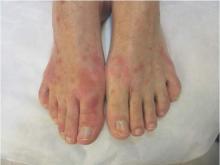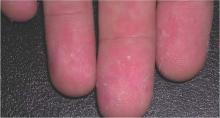Dermatologists may be seeing patients who have recently traveled to an area affected by the current Zika outbreaks, who present with a rash and possibly a fever.
Before serology and possibly virology confirms the diagnosis, there are certain distinguishing characteristics that may help distinguish Zika initially from dengue and Chikungunya, according to Dr. Stephen K. Tyring.
Dr. Tyring, clinical professor of dermatology at the University of Texas, Houston, said in an interview that serology is required to confirm the diagnosis, and should be obtained via state and local health departments, which are increasingly being provided with test kits. Virology via polymerase chain reaction also may be needed to diagnose the infection.
About 20% of people infected with Zika virus develop symptoms. In Texas, by early February, 10 cases had been diagnosed statewide.
The Zika rash is characterized by blanchable macules and papules, which may start on the face or trunk 3-5 days after the febrile phase, and become more diffuse, said Dr. Tyring.
The erythematous macules with areas of sparing is similar to the rash seen with Chikungunya and dengue, two other viral infections that have cutaneous manifestations. With a Zika rash, macules are more likely than papules, but papules are certainly possible, he said.
In addition, someone with a Zika infection is more likely to have conjunctivitis than someone with dengue or Chikungunya, and may have red sclera, he noted. But all the other symptoms associated with dengue and Chikungunya, such as the arthralgias, headaches, and myalgias, could certainly be present with Zika as well, as the three diseases have similar clinical features.
Dr. Tyring referred to a study published in 2009 describing 31 cases in a 2007 Zika outbreak in Micronesia, which reported that 90% (28 patients) had a macular or papular rash. In addition, 20 (65%) had a mild fever, 20 (65%) had arthralgia of the small joints, and 17 (55%) had nonpurulent conjunctivitis (N Engl J Med. 2009 Jun 11;360[24]:2536-43).
In September, when Dr. Tyring was attending the Brazilian Society of Dermatology meeting in Sao Paolo, he visited some clinics and saw some of the first patients diagnosed with Zika virus – before the connection with the microcephaly or Guillain-Barre had been made. Serologic testing had confirmed that the cases were Zika infections, not Chikungunya or dengue.
At that time, cases were being viewed as a mild versions of Chikungunya or dengue, “in other words, nothing that they were fearing any more than all the other arboviruses that are so common,” Dr. Tyring said in an interview.
With some of the patients, “we saw a bit of desquamation of the extremities, such as the fingertips,” he said. (See photos.) “But generally, it’s not very distinguishable between dengue and Chikungunya.”
Health care providers are encourage to report suspected cases to their state health departments.




